Philippine Air Force
The Philippine Air Force (PAF; Filipino: Hukbong Himpapawid ng Pilipinas) is the aerial warfare service branch of the Armed Forces of the Philippines. Initially formed as part of the Philippine Army (Philippine Army Air Corps), the PAF is responsible for both defending the Philippine Airspace, and conducts close air support, combat air patrols, tactical operations and other aerial operations throughout the Philippines.
| Philippine Air Force | |
|---|---|
| Hukbong Himpapawid ng Pilipinas | |
 Philippine Air Force seal | |
| Active | January 2, 1935 (PMA-PAAC) July 1, 1947 (PAF) |
| Country | |
| Type | Air force |
| Size | 16,000 personnel[1] 193 total aircraft |
| Part of | Philippine Armed Forces |
| Headquarters | Villamor Air Base |
| Nickname(s) | PAF |
| Motto(s) | The "First Force" |
| Colors | Air Force Blue |
| March | Philippine Air Force Hymn[2] |
| Engagements | World War II Hukbalahap Rebellion Communist insurgencies Moro conflict 1986–90 Philippine coup attempts Spratly Islands Dispute Operation Enduring Freedom - Philippines Battle of Marawi |
| Website | www |
| Commanders | |
| Commander-in-Chief | Rodrigo Duterte |
| Secretary of National Defense | Delfin Lorenzana |
| Chairman of the Joint Chiefs | General Felimon Santos Jr., AFP |
| Chief of the Air Force | Lieutenant General Allen T. Paredes, AFP |
| Deputy Chief of the Air Force | Major General Pelagio R. Valenzuela |
| Chief of the Air Force Staff | Major General Florante M. Amano |
| Air Force Sergeant Major | Chief Master Sergeant Nelson S. Mercado |
| Insignia | |
| Roundel | |
| Flag |  |
| Aircraft flown | |
| Attack | A-29B, AS-211, OV-10A/C, SF-260TP/MP |
| Fighter | FA-50PH |
| Helicopter | Bell 412EP, UH-1 Huey, W-3A, S-70i Blackhawk, S-76A/AUH-76 |
| Attack helicopter | MD520MG, AH-1F Cobra, AW109E Power |
| Patrol | F27-200MAR, C-130 |
| Reconnaissance | Aero Commander, Cessna 208 Caravan, Boeing Insitu ScanEagle, Hermes 450, Hermes 900 |
| Trainer | SF-260FH, T-41B/D |
| Transport | IPTN NC-212 Aviocar, C-130B/H/T, Fokker F27, F-28-3000, Gulfstream G280, N-22B, C-295M |
The PAF has an estimated strength of over 16,000 personnel and operates 193 aircraft.
History
Philippine Commonwealth and Independence
Early years and World War II
The forerunners of the Philippine Air Force was the Philippine Militia, otherwise known as Philippine National Guard (PNG). On March 17, 1917 Senate President Manuel L. Quezon enacted a bill (Militia Act 2715) for the creation of the Philippine Militia. It was enacted in anticipation that there would be an outbreak of hostilities between United States and Germany.[3]
By the end of the First World War, the US Army and Navy began selling aircraft and equipment to the Philippine Militia Commission. The Commission then hired the services of the Curtiss Flying School to provide flight training to 33 students at Camp Claudio, Parañaque.
The early aviation unit was, however, still lacking enough knowledge and equipment to be considered as an air force and was then limited only to air transport duties.[3] On January 2, 1935, Philippine Military Aviation was activated when the 10th Congress passed Commonwealth Act 1494 that provided for the organization of the Philippine Constabulary Air Corps (PCAC). PCAC was renamed the Philippine Army Air Corps (PAAC) in 1936. It started with only three planes on its inventory. In 1941, PAAC had a total of 54 aircraft including pursuit (fighters) light bombers, reconnaissance aircraft, light transport and trainers.[3] They later engaged the Japanese when they invaded the Philippines in 1941–42, and were reformed in 1945 after the country's liberation.
Post-WWII and AFP restructuring
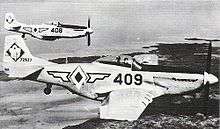
The PAF became a separate military service on July 1, 1947, when President Manuel Roxas issued Executive Order No. 94. This order created the Philippine Naval Patrol and the Air Force as equal branches of the Philippine Army and the Philippine Constabulary under the now Armed Forces of the Philippines[4] becoming Southeast Asia's third air force as a result.
The main aircraft type in the earlier era of the PAF was the P-51 Mustang, flown from 1947 to 1959. Ground attack missions were flown against various insurgent groups, with aircraft hit by ground fire but none shot down. In the 1950s the Mustang was used by the Blue Diamonds aerobatic display team.[5] These would be replaced by the jet-powered North American F-86 Sabres in the late 1950s, assisted by Lockheed T-33 Shooting Star and Beechcraft T-34 Mentor trainers.
The PAF saw its first international action in the Congo under the UN peacekeeping mission in 1960.
Cold War Era
Marcos rule and People Power Revolution
During the 70s, the PAF was actively providing air support for the AFP campaign against the MNLF forces in Central Mindanao, aside from doing the airlifting duties for troop movements from Manila and Cebu to the warzone. Traditional workhorses like the UH-1H choppers, L-20 “Beaver” aircraft, and C-47 gunships were mainly used in the campaign. In the same decade, the PAF Self-Reliance Development Group, the forerunner of the Air Force Research and Development Center (AFRDC) was created. The Center enabled the PAF to create prototypes of aircraft aside on going into partnership with the private sector for some of its requirements.[6]
In late 1977, the Philippine government purchased 35 secondhand U.S. Navy F-8Hs that were stored at Davis-Monthan AFB in Arizona. Twenty-five of them were refurbished by Vought and the remaining 10 were used for spare parts. As part of the deal, the U.S. would train Philippine pilots in using the TF-8A. They were mostly used for intercepting Soviet bombers. The F-8s were grounded in 1988 and were finally withdrawn from service in 1991 after they were badly damaged by the Mount Pinatubo eruption, and have since been offered for sale as scrap.[7]
On February 24, 1986 at the height of the "EDSA Revolution", the 15th Strike Wing defected to the Ramos-Enrile camp, taking their squadrons of S-76 “Sikorsky” that later dictated the EDSA People Power Revolution which effectively ended the Marcos rule.
1986–1990 Coup attempts
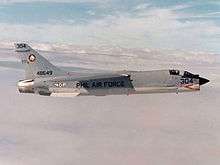
The following years remained hostile for the Philippines, a series of bloody coup attempts led by then-Col Gregorio Honasan of the Reform the Armed Forces Movement, involved thousands of renegade troops, including elite units from the army and marines, in a coordinated series of attacks on Malacanang and several major military camps in Manila and surrounding provinces, including Sangley and Villamor Air Base, using the T-28 aircraft for aerial assaults. President Corazon Aquino found it necessary to request United States support to put down the uprising. As a result, a large US special operations force was formed and named Operation Classic Resolve, as USAF F4 fighter aircraft stationed at Clark Air Base patrolled above rebel air bases, and two aircraft carriers were positioned off the Philippines. The US operation soon caused the coup to collapse. Additional US forces were then sent to secure the American embassy in Manila. The military uprisings resulted in an estimated US$1.5 billion loss to the Philippine Economy.[8]
US Military departure from the Philippines
The Cold War Era has reached its endpoint as tensions between the two ideological rivals, the United States and the Soviet Union, have simmered down as a result of the dissolution of the latter and the massive change of political system among its allies.
The fate of the US military bases in the country was greatly affected by these circumstances, aside from the catastrophic eruption of Mount Pinatubo in 1991 which engulfed the installations with ash and lahar flows. The nearby Clark Air Base was eventually abandoned afterwards, while the Philippine Senate voted to reject a new treaty for Subic Naval Complex, its sister American installation in Zambales. This occurrence had effectively ended the century-old US military presence in the country, even as President Corazon Aquino tried to extend the lease agreement by calling a national referendum, leaving a security vacuum in the region and terminated the inflows of economic and military aid into the Philippines. [9] [10]
Contemporary Era
AFP modernization efforts and Asian Financial Crisis
The importance of territorial defense capability was highlighted in the public eye on 1995 when the AFP published photographs of Chinese structures on Mischief Reef in the Spratlys.
Initial attempts to improve the capabilities of the Armed Forces happened when a law was passed in the same year for the sale of redundant military installations and devote 35 percent of the proceeds for the AFP upgrades. Subsequently, the legislature passed the AFP Modernization Act. The law sought to modernize the AFP over a 15-year period, with minimum appropriation of 10-billion Pesos per year for the first five years, subject to increase in subsequent years of the program. The modernization fund was to be separate and distinct from the rest of the AFP budget.
However, the Asian Financial Crisis struck the region on 1997. This has greatly affected the AFP Modernization Program due to the government's austerity measures meant to turn the economy around after suffering from losses incurred during the financial crisis.[11]
Several air assets acquired by the Philippine Air Force thru the original AFP Modernization Program of 1995 were the AW109 armed scout helicopters, and airlift assets like the Airbus C295 and CASA C212 Aviocar. [12]
A decade of neglect
Since the retirement of the Northrop F-5s in September 2005 without a planned replacement, the Philippine air force was left without fighter jets.[13] The PAF resorted to the Aermacchi S-211 trainer jets to fill the void left by the F-5's. These S-211's were later upgraded to light attack capability and used for air and sea patrol and also performed counter-insurgency operations from time to time.[14] The only active fixed wing aircraft to fill the roles were the SF-260 trainers with light attack capability, the OV-10 Bronco light attack and reconnaissance aircraft and the AS-211 warriors (upgraded S-211).
South China Sea arbitration case and revised AFP Modernization Program
The incidents with Chinese presence in the South China Sea prompted the Philippines to proceed with formal measures while challenging the Chinese activities in some of the sea features in the disputed island chain. Hence, the South China Sea Arbitration Case was filed by the Philippines in 2013 at the International Tribunal for the Law of the Sea (ITLOS).[15]
Reminiscent to what occurred in 1995, the Congress passed the Revised AFP Modernization Act of 2012, this was meant to replace the older AFP Modernization Act of 1995 signed during former Pres. Fidel V. Ramos’ term, when its 15-year program effectivity expired in 2010.[16]
.jpg)
Major air assets acquired in this new modernization program iteration are 12 FA-50 Light Fighters, while those programmed for future procurements are the Multi-Role Fighters and the Maritime Patrol Aircraft, among other equipment.[17]
Flight Plan 2028
In response to regional strategic challenges and perceived internal weaknesses, the PAF has embarked on a transformation process to enhance its capabilities. Flight Plan 2028 is administered by the Air Force Strategy Management Office (AFSMO), and aims to:
- Build the PAF capability to detect, identify, intercept and neutralize intrusions in the Philippine Air Defense Identification Zone (PADIZ) and the South China Sea (to the North and West of the archipelago) from Area Readiness 4 to Area Readiness 3 by 2022.
- Build the PAF capability to detect, identify, intercept and neutralize intrusions into the entire Philippine territory from Area Readiness 3 to Area Readiness 1 by 2028;
The plan calls for a reorienting of the Philippine Air Force from a primarily internal security role to a territorial defence force. It will require substantial organisational, doctrinal, training, strategic and equipment transformation.
US-Philippine Enhanced Defence Cooperation Agreement
In April 2014, the Enhanced Defense Cooperation Agreement was signed by the representatives of the Philippine and US Governments, aimed at bolstering the military alliance of both countries. The agreement allows the United States to rotate troops into the Philippines for extended stays and allows the U.S. to build and operate temporary facilities on Philippine military bases for both American and Philippine forces' use.[18] [19]
Both parties agreed to determine the military installations across the Philippines as covered by the pact, including the former US Subic Bay Naval Base and Clark Air Base, as well as several locations on Cebu, Luzon, and Palawan. [20]
As of 2016, four PAF bases and one Army camp have been determined by the United States and the Philippines to be utilized under the agreement. The Air Force Bases are Basa Air Base, Antonio Bautista Air Base, Benito Ebuen Air Base, and Lumbia Airfield.[21]
Organization
The Philippine Air Force is commanded by the Chief of the Air Force, holding the rank of Lieutenant General, and is assisted by the Vice Chief of the Philippine Air Force, and the Chief of Air Staff, in charge of organizational and administrative matters, both holders of the rank of Major General. The Philippine Air Force consists of three tactical commands, three support commands, and seven air wings.
Tactical commands
The three Tactical Commands are in the direct control of the PAF Leadership while serving his function in the command chain of the AFP. These units are jointly reactivated and reorganized on July 21, 2017 while effectively replacing the 1st, 2nd, and 3rd Air Divisions as part of the PAF Flight Plan 2028.[22]
- Air Defense Command
- Air Mobility Command
- Air Combat Command (formerly Tactical Operations Command)
Support commands
- Air Logistics Command
- Air Education, Training, and Doctrine Command
- Air Force Reserve Command
Air wings
5th Fighter Wing, Basa Air Base – It is responsible for air defense and interdiction. It replaced the Air Defense Wing after the two were reactivated to their original status on 2017.
- Flying units:
- 7th Tactical Fighter Bulldogs Squadron – currently flies the KAI FA-50PH Fighting Eagle multirole fighter aircraft.
- 105th Fighter Training Blackjacks Squadron – conducts jet qualification and training for future fighter-bound pilots. Currently flies the Aermacchi AS-211 jet training aircraft.
15th Strike Wing, Danilo Atienza Air Base – It is responsible for providing combat air support to surface forces of the AFP.[23]
- Flying Units:
- 16th Attack Eagles Squadron – currently flies the Rockwell OV-10A/C/M Bronco
- 17th Attack Jaguars Squadron – currently flies the Aermacchi SF-260TP
- 18th Attack Falcons Squadron – currently flies the Leonardo AW109E Power
- 19th Composite Tactical Training Griffins Squadron - currently flies the AH-1F Cobra
- 20th Attack Firebirds Squadron – currently flies the McDonnell Douglas MD-520MG Defender
- Support Units:
- 590th Air Base Group
- 460th Maintenance and Supply Group
205th Tactical Helicopter Wing, Benito Ebuen Air Base – It is responsible for conducting tactical helicopter operations in support of the PAF and AFP.[24] The wing currently flies the Bell UH-1H Huey, Dornier-Bell UH-1D Huey, and Bell 412EP helicopters.
- Flying Units:
- 206th Tactical Helicopter Hornets Squadron
- 207th Tactical Helicopter Stingers Squadron
- 208th Tactical Helicopter Daggers Squadron
- 210th Tactical Training Squadron
- Support Unit:
- 450th Maintenance and Support Group
220th Airlift Wing, Benito Ebuen Air Base – It provides tactical airlift operations in support of the AFP. It is also currently the unit temporarily responsible for conducting long range maritime patrol and air reconnaissance.[25]
- Flying Units:
- 221st Airlift Squadron – currently flies the Airbus C-295M and Fokker F27 Friendship medium tactical transport aircraft
- 222nd Airlift Squadron – currently flies the Lockheed C-130B/H/T Hercules heavy tactical transport aircraft
- 223rd Airlift Squadron – currently flies the GAF N-22B/C Nomad and EADS-IAe NC-212i light tactical transport aircraft
- 228th Transport Crew and Training Squadron
- Support Unit:
- 470th Maintenance Support Group
250th Presidential Airlift Wing, Villamor Air Base – It provides air transportation to the President of the Philippines, immediate members of his/her family, heads of states, state guests, and very very important persons (VVIP).[26]
- Flying Units:
- 251st Presidential Airlift Squadron – currently flies the Fokker F27 Friendship and Fokker F28 Fellowship VVIP aircraft.
- 252nd Presidential Airlift Squadron – currently flies the Bell 412EP/HP VVIP helicopters.
- Support Unit:
- 480th Maintenance and Supply Group
300th Air Intelligence and Security Wing, Antonio Bautista Air Base – responsible for conducting surveillance, intelligence gathering, and maritime patrol using air and ground assets.
- Flying Units:
- 3031st Unmanned Aerial Reconnaissance Squadron – flies the ScanEagle UAVs.
- 3032nd Aerial Reconnaissance Squadron – currently flies the Cessna 208B Grand Caravan ISR and Turbo Commander 690A ISR aircraft, also provide ISR equipment operators for SABIR-equipped C-130T Hercules when configured for Maritime Patrol Aircraft missions.
355th Aviation Engineering Wing, Clark Air Base – the unit is tasked to provide general engineering support, including construction, repair, rehabilitation and maintenance of PAF aerodrome facilities and utilities.[27]
580th Aircraft Control and Warning Wing, Wallace Air Station – It is responsible for operating air defense and surveillance radar systems of the PAF. It was reactivated on November 3, 2016 after being downgraded to a Group on April 1, 2005.[28]
710th Special Operations Wing, Colonel Ernesto Rabina Air Base – It is responsible for conducting special operations, counter terrorism, and defense of PAF bases and facilities. The unit is also being groomed to be responsible for ground-based air defense system (GBADS) units which is being inducted into the PAF's future capabilities.
- Combat Units:
- 720th Special Operations Group – based in Villamor Air Base, Pasay City
- 730th Combat Group
- 740th Combat Group – based in Fernando Air Base, Lipa City
- 750th Combat Group – based in Camp General Emilio Aguinaldo, Quezon City
- 760th Combat Group
- 770th Special Operations Combat Support Group – based in Clark Air Base, Angeles
- 772nd Explosive Ordnance Disposal Squadron
- 773rd K-9 Squadron
- 780th Ground Based Air Defense Group
Separate units
505th Search and Rescue Group, Villamor Air Base – It is responsible for air search and rescue operations in support of the AFP and civilian agencies.[29] The unit currently flies the Bell 205A, UH-1H Huey II, Bell UH-1H Super Huey, and the PZL W-3A Sokół as SAR helicopters, and the Sikorsky S-76A and S-70 as Air Ambulances.
- Flying Units:
- 5051st Search and Rescue Squadron
- 5052nd Search and Rescue Squadron
900th Air Force Weather Group
Aerobatic teams
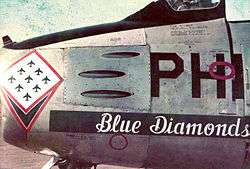
The Philippine Air Force had a number of aerobatic teams among which the PAF Blue Diamonds was the first to be founded, and was one of the oldest formal aerobatics teams in the world. The proceeding units listed are currently at inactive status due to the retirement of their aircraft, most notably the Northrop F-5 Freedom Fighters.
- Blue Diamonds – 5th Fighter Wing, Air Defense Command
- Red Aces – 7th Tactical Fighter Squadron, 5th FW
- Golden Sabres – 9th Tactical Fighter Squadron, 5th FW (merged with the Red Aces on 1973)
- Bubuyogs – PAF Helicopter Precision Demonstration Team, 205th Tactical Helicopter Wing
Bases
The Philippine Air Force has nine major air bases and several radar, communications, and support facilities located throughout the archipelago. Shared facilities with commercial airports currently being used as detachments by the Tactical Operations Command were not included here.
| Luzon | Location |
|---|---|
| Colonel Jesus Villamor Air Base | Pasay City, Metro Manila |
| Clark Air Base | Angeles, Pampanga |
| Colonel Ernesto Rabina Air Base | Capas, Tarlac |
| Cesar Basa Air Base | Floridablanca, Pampanga |
| Basilio Fernando Air Base | Lipa, Batangas |
| Danilo Atienza Air Base | Cavite City, Cavite |
| Wallace Air Station | San Fernando, La Union |
| Paredes Air Station | Pasuquin, Ilocos Norte |
| Gozar Air Station | Lubang, Occidental Mindoro |
| Parañal Air Station | Jose Panganiban, Camarines Norte |
| Visayas | |
| Benito Ebuen Air Base | Mactan, Cebu |
| Guiuan Airfield | Guiuan, Eastern Samar |
| Antonio Bautista Air Base | Puerto Princesa, Palawan |
| Mt. Salakot Air Station | Puerto Princesa, Palawan |
| Mindanao | |
| Edwin Andrews Air Base | Zamboanga City |
| Rajah Buayan Air Station | City of General Santos |
| Lumbia Airfield | Cagayan de Oro, Misamis Oriental |
Current inventory
Aircraft
.jpg)
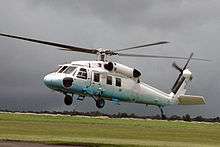
Modernization program
The following equipment listed below are either scheduled for delivery or in the planning stages for the next 'horizons' of the AFP Modernization Program.
Combat aircraft
Multi-role fighters
There were several occasions that the PAF tried to modernize its fighter aircraft force, which was left to decline for several decades.
In 1991 the newly democratic Russian government offered the PAF several of its aircraft including the Mikoyan MiG-29 and Sukhoi Su-27 during a demonstration held at Villamor Air Base, but the Russian jets could not satisfy the PAF requirements. In 1992 the PAF received offers for both the IAI Kfir and the F-16 Fighting Falcon.[41]
After the enactment of the 1995 AFP Modernization Act, the PAF made renewed calls to purchase several fighter aircraft, with the initial plan of having 36 multirole fighters in a span of 15 years.[42] Offers included the American Lockheed Martin F-16C/D Falcon and McDonnell Douglas (now Boeing) F-18C/D Hornet, French Dassault Mirage 2000-5, and the Russian Mikoyan MiG-29. Also offered as alternatives were the embargoed Pakistani F-16A/Bs and ex-French Air Force Mirage F1, and ex-South African Air Force Denel Cheetahs which were rejected as the government was then inclined on obtaining new-build platforms.[43] However, these modernization programs were put on hold after the Philippines' economy was impacted by the 1997 Asian Financial Crisis.
Renewed interest would later come on used platforms. In June 2010, the Department of National Defense (DND) was also looking at Canada for used CF-18s or France for its used Mirage F1s, although no decision or purchase came up.[44]
In December 2011, the DND and Department of Foreign Affairs (DFA) was tasked to formally request at least a squadron of 12 ex-USAF F-16C/D fighter jets, most probably Block 25 or 30 which would be refurbished to either Block 50 or 52 standards.[45] This was discussed during the US-Philippines "2+2" Meeting on April 30, 2012. The Philippine government would pay for refurbishing, maintenance and pilot training which would run for two years.[46]
However, by 2012 the maintenance costs for the used fighters were found to be too high so attention turned to new jet trainers that could be converted into jet fighters. The requirements were listed as "supersonic ability, multifunction displays and On Board Oxygen Generation System."[47] A DND spokesman has said that aircraft from France, the United Kingdom, Italy, and South Korea were considered.[48]
It was reported that the DND will be acquiring multirole fighters by 2018.[49] In responding to the Philippine desire for multirole fighters, the United States offered variants of the General Dynamics F-16 Fighting Falcon, and Sweden offered the Saab JAS 39 Gripen.[50][51] Through thorough study and research, the Department of National Defense prefers the Swedish-made Gripen multi-role supersonic jet fighter.[52][53]
Close air support aircraft
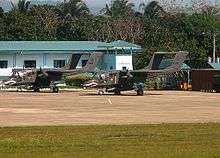
The Philippine Air Force is looking to replace its entire OV-10 Bronco fleet which are currently used for close air support and aerial reconnaissance platforms. Being considered are the Hawker Beechcraft AT-6B Texan II, Embraer EMB-314 Super Tucano, KAI KA-1 Woongbi, Elbit Systems L-159, and reportedly, the Air Tractor AT-802U.[54] A decision from the PAF & DND was expected to be released by July 2012, but was moved to the fourth quarter of 2014 due to bureaucratic constraints.
Hawker Beechcraft demonstrated their AT-6B Texan II, together with their other aircraft line, in April 2012 with a display at Clark Air Base.[55]
On June 20, 2012, it was reported that the Embraer EMB 314 Super Tucano from Brazil is a possible contender for its aircraft for a total of 6 units, which will be acquired for PhP4.968 billion (US$115 million).[56]
In late November 2017, a statement by Embraer noted that the Philippine Air Force had placed an order for 6 Super Tucano aircraft.[57][58][59] These planes are set to replace the OV-10 Broncos of the PAF.
Attack Helicopters
As of April 27, 2018, negotiations are ongoing for the donation of 2 Bell AH-1F Cobra attack helicopters and several dozen M113A2 armored personnel carriers from the Kingdom of Jordan to help the Philippine Government combat ISIS terrorists.[60]
The Philippines formerly plans to acquire 24 light-attack helicopters for its requirement, they will procure these helicopters on Horizon 2 Phase, AFP Modernization which covers to 2018–2022, now it had been changed to purposely built attack helicopters, with the TAI/AgustaWestland T129 ATAK[61] as the main pick by the Defense Department. However, due to the sanctions imposed by the US Government on Turkey, and the failure of the delivery of its engines from the UK and the US, the PAF Technical Working Group (TWG) decided to drop the T129 helicopter acquisition and selected American made helicopters instead, with the Bell AH-1Z Viper, the Boeing AH-64 Apache, and the PZL Mielec S70i Attack Helicopter being offered by the US for the project.[62]
Transport aircraft
Combat Utility Helicopters
Following the abrupt cancellation for the order of 16 Bell 412EPi Helicopters from the Canadian Division of Bell Helicopters through a government-to-government contract with the Canadian Commercial Cooperation (CCC),[63] parent company Textron, Inc announced on April 27, 2018 that negotiations were ongoing for the continuation of the sale using their factory in Texas, USA as the manufacturer.[64]
During a hearing by the Senate for the budget of the Department of National Defense for 2019, the Commanding General of the PAF confirmed that there are four shortlisted helicopter models for the Combat Utility Helicopter acquisition project: the Bell 412EPI but specifically sourced from the US instead of Canada, the Sikorsky Black Hawk which is considered an expensive option but can be considered based on the package included in the offer; Leonardo's AW139M helicopter, and Russia's Mil Mi-171.[65] And on December 7, 2018, the Defense Department selected the Sikorsky UH-60 Black Hawk[61] Helicopters. In March 2019, the Philippines’ Department of National Defense (DND) signed a contract worth US$241.4 million with Lockheed Martin's Polish subsidiary PZL Mielec to deliver 16 units of Sikorsky's S-70i Black Hawk combat utility helicopters for the Philippine Air Force (PAF), and the Notice to Proceed (NTP) was provided by DND to PZL Mielec by April 16, 2019.[66]
Search and Rescue aircraft
Seaplanes
In November 2013, the DND released an invitation to bid for the acquisition of 3 brand new Search and Rescue seaplanes with an Integrated Logistics package (ILS). The DND has allotted 2.67 billion pesos for this project. The pre-bid conference was scheduled at November 15, 2013 while the actual bidding was scheduled at November 29, 2013. The seaplanes being offered should be used by the Armed Forces of the country of origin or by the Armed Forces of at least 2 other countries.[67]
Long-Range Patrol Aircraft
On July 1, 2014, President Benigno Aquino III announced plans to acquire 2 long range patrol aircraft.[68] A budget of P5.976 million has been allotted under the revised Armed Forces modernization program.[69] Companies reported to have bought bid documents include Alenia Aermacchi, Airbus Military and Elta System Ltd.
See also
References
- "Archived copy". Archived from the original on July 29, 2017. Retrieved June 29, 2017.CS1 maint: archived copy as title (link)
- https://www.filipinaslibrary.org.ph/himig/philippine-air-force-march/
- "History". Philippine Air Force. Archived from the original on July 10, 2012. Retrieved July 21, 2012.
- "PAF History". paf.mil.ph. Philippine Air Force. Archived from the original on September 25, 2012. Retrieved June 24, 2012.
- Hellstroem, Leif. Philippine Front Line: P-51 Mustangs with the Philippine Air Force Air Enthusiast #75 May–June 1998 pp52-61
- "PAF History". paf.mil.ph. Philippine Air Force. Archived from the original on December 5, 2017. Retrieved March 19, 2018.
- "F-8 History". MILAVIA. Archived from the original on October 18, 2015. Retrieved March 19, 2018.
- "Operation Classic Resolve". globalsecurity.org. Archived from the original on March 19, 2018. Retrieved March 19, 2018.
- "PHILIPPINE SENATE VOTES TO REJECT U.S. BASE RENEWAL". The New York Times. Archived from the original on March 19, 2018. Retrieved March 19, 2018.
- "CLOSURE OF U.S. MILITARY BASES IN THE PHILIPPINES: IMPACT AND IMPLICATIONS" (PDF). dtic.mil. Archived (PDF) from the original on March 29, 2018. Retrieved March 19, 2018.
- Archived March 21, 2018, at the Wayback Machine, Retrieved March 21, 2018.
- Archived 2018-03-22 at the Wayback Machine, Retrieved March 21, 2018.
- http://www.philstar.com/philstar/news200509299901.htm%5B%5D
- John Pike. "SIAI-Marchetti AS-211 Warrior". globalsecurity.org. Archived from the original on September 27, 2013. Retrieved September 26, 2013.
- Archived March 21, 2018, at the Wayback Machine, Retrieved March 21, 2018
- Archived 2018-03-22 at the Wayback Machine, Retrieved March 21, 2018
- Archived March 21, 2018, at the Wayback Machine, Retrieved March 21, 2018
- Archived March 22, 2018, at the Wayback Machine, Retrieved March 21, 2018.
- , Retrieved March 21, 2018.
- Archived March 22, 2018, at the Wayback Machine, Retrieved March 21, 2018.
- Archived March 21, 2018, at the Wayback Machine, Retrieved March 21, 2018.
- "Air Force Holds Joint Ceremony for the Deactivation of Air Defense Wing, 1AD, 2AD & 3AD; Reactivation of ADC and Tactical Operations Command; and Activation of Air Mobility Command". paf.mil.ph. Philippine Air Force. July 21, 2017. Archived from the original on September 29, 2017. Retrieved March 19, 2018.
- "About Us". 15th Strike Wing, Philippine Air Force. Archived from the original on December 20, 2016. Retrieved December 17, 2016.
- "205th Unit". 205th Tactical Helicopter Wing, Philippine Air Force. Archived from the original on December 20, 2016. Retrieved December 17, 2016.
- "Mission and Function". 220th Airlift Wing, Philippine Air Force. Archived from the original on December 22, 2016. Retrieved December 17, 2016.
- "Mission Function". 250th Presidential Airlift Wing, Philippine Air Force. Archived from the original on December 20, 2016. Retrieved December 17, 2016.
- "Mission Function". 355th Aviation Engineering Wing, Philippine Air Force. Archived from the original on December 20, 2016. Retrieved December 17, 2016.
- "580th Control and Warning Group Reactivates into a Wing". Philippine Air Force. November 7, 2016. Archived from the original on December 20, 2016. Retrieved December 17, 2016.
- "Mission & Function". 505th Search and Rescue Group, Philippine Air Force. Archived from the original on December 20, 2016. Retrieved December 17, 2016.
- "World Air Forces 2020". Flightglobal Insight. 2020. Retrieved December 10, 2019.
- "North American Rockwell OV-10 Bronco Observation / Light Attack Aircraft (1966)". www.MilitaryFactory.com. Military Factory. Retrieved December 19, 2013.
- "What it cost the Philippine Air Force to get a Gulfstream G280". bizjournals.com. Retrieved December 10, 2019.
- "Air Force to get 2 more C-130 planes". pna.gov.ph. Retrieved June 10, 2020.
- "Arms Transfers Database". Stockholm International Peace Research Institute. Retrieved February 19, 2013.
- "PAF attack capabilities up with 'Cobra' choppers". pna.gov.ph. Retrieved May 14, 2020.
- "All PAF W-3A 'Sokols' operational". Zambotimes. Retrieved December 24, 2014.
- "250th Presidential Airlift Wing". globalsecurity.org. Retrieved July 3, 2015.
- "US delivers ScanEagle UAS to Philippine Air Force". IHS Jane's Defence Weekly. Retrieved March 13, 2018.
- "PH to aquire 8 more scaneagle". Businessmirror.ph. Retrieved June 6, 2019.
- "Philippines receives UAV's". globalnation.inquirer.net. 2020. Retrieved June 25, 2020.
- "Modernization Options". Opus224's Unofficial Philippine Defense Page. Archived from the original on June 24, 2012.
- "Republic Act 7898: AFP Modernization Act" (PDF). Congress, Republic of the Philippines. February 23, 1995. Archived from the original (PDF) on March 26, 2009. Retrieved April 8, 2009.
- "Manila narrows fighter choice". Flight International. October 15, 1996. Archived from the original on December 16, 2008. Retrieved July 2, 2010.
- "DND Shopping around for heavy weapons, trucks". Philstar Online. June 4, 2010. Archived from the original on June 11, 2015. Retrieved November 20, 2013.
- "Philippines seeks 12 F-16 fighter jets from US". Huffington Post. December 21, 2011. Archived from the original on April 29, 2014. Retrieved January 18, 2012.
- "PAF seeks 12 F-16 fighter jets from US". April 19, 2012. Archived from the original on April 29, 2014. Retrieved April 28, 2012.
- "Purchase of new jet fighter eyed." Archived January 31, 2016, at the Wayback Machine BusinessWorld, May 16, 2012.
- Dudley, Richard. "Philippines Looking to Buy Non-USA Combat Aircraft." Archived May 25, 2012, at the Wayback Machine Defense Update, May 20, 2012.
- "PHL to get MRF by 2018". balita.ph. April 1, 2014. Archived from the original on April 8, 2014. Retrieved April 8, 2014.
- Grevatt, Jon (October 10, 2018). "US offers to meet Philippine air combat requirements". IHS Jane's 360. Bangkok. Archived from the original on October 12, 2018. Retrieved October 12, 2018.
- Grevatt, Jon (June 13, 2018). "Saab's Gripen positioned for Philippines fighter requirement". IHS Jane's 360. Bangkok. Archived from the original on June 14, 2018. Retrieved October 12, 2018.
- DND plans to buy Sweden-made jets http://manilastandard.net/news/top-stories/278089/dnd-plans-to-buy-sweden-made-jets.html Archived October 16, 2018, at the Wayback Machine
- http://www.pna.gov.ph/articles/1051097 Archived October 15, 2018, at the Wayback Machine DND likely to acquire Swedish-made fighter jets
- "Philippines to consider OV-10 replacement". Flightglobal. January 18, 2011. Archived from the original on January 21, 2011. Retrieved April 28, 2012.
- "AT-6 Texan @ Clark". Archived from the original on December 24, 2014. Retrieved December 24, 2014.
- "Kickback, ikinakatakot sa pagbili ng fighter jets". ABS-CBNnews.com. June 20, 2012. Archived from the original on June 20, 2012. Retrieved June 21, 2012.
- Waldron, Greg (November 30, 2017). "Manila to beef up attack capability with Super Tucano". FlightGlobal. Singapore. Archived from the original on December 3, 2017. Retrieved December 3, 2017.
- Khan, Bilal (November 30, 2017). "Philippines orders six A-29 Super Tucano from Embraer". Quwa Defence News & Analysis Group. Archived from the original on December 3, 2017. Retrieved December 3, 2017.
- "Philippine Air Force Selects the A-29 Super Tucano for Close Air Support Role". Embraer. São Paulo, Brazil. November 30, 2017. Archived from the original on December 3, 2017. Retrieved December 3, 2017.
- "Archived copy". Archived from the original on August 14, 2018. Retrieved April 28, 2018.CS1 maint: archived copy as title (link)
- "Philippine Air Force picks Black Hawks, T129 ATAK choppers |". newsinfo.inquirer.net. Archived from the original on December 14, 2018. Retrieved January 5, 2019.
- https://www.mintfo.com/news/paf-reportedly-selects-american-helicopter-for-attack-helicopter-project-after-re-evaluation/19835/
- "Archived copy". Archived from the original on April 29, 2018. Retrieved April 28, 2018.CS1 maint: archived copy as title (link)
- "Archived copy". Archived from the original on April 27, 2018. Retrieved April 28, 2018.CS1 maint: archived copy as title (link)
- "MaxDefense Philippines". www.facebook.com.
- "Philippines orders 16 Sikorsky S-70i Black Hawk utility helicopters".
- "INVITATION TO BID Search and Rescue Seaplane Acquisition Project" (PDF). Department of National Defense (Philippines). Archived (PDF) from the original on March 14, 2014. Retrieved March 14, 2014.
- "Aquino announces new assets for Philippine Air Force". Solar News Online. July 1, 2014. Archived from the original on July 14, 2014. Retrieved July 1, 2014.
- "DND postpones bidding for major ticket items". The Philippine Star. June 15, 2014. Archived from the original on June 17, 2014. Retrieved June 15, 2014.
External links
| Wikimedia Commons has media related to Philippine Air Force. |
_cropped.jpg)

.svg.png)